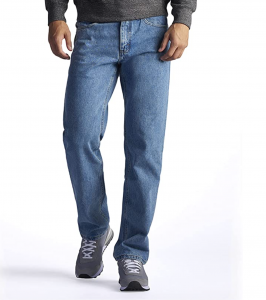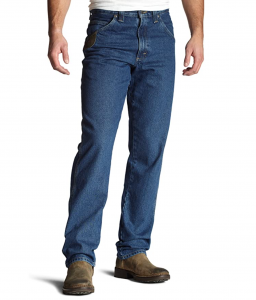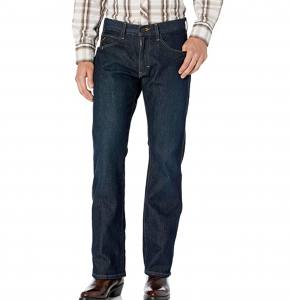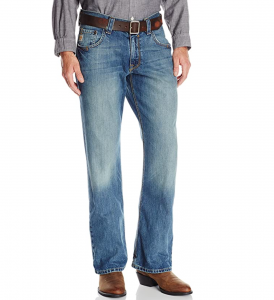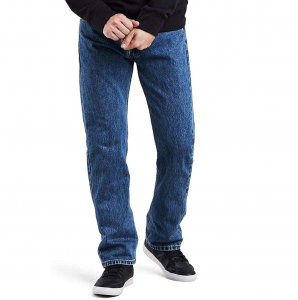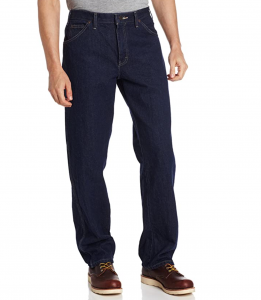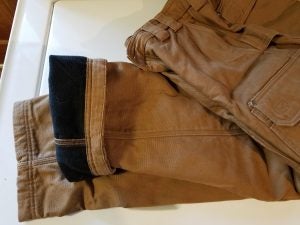With so many brands and styles to pick from, it’s easy to get lost in all of the blue jeans that are available out there. Actually, let us clarify — we mean work jeans. You won’t be seeing the latest styles from The Gap on this list. We live and breathe work clothes, and want you to find the best work jeans that are right for what you do.
Some jeans are most durable in the knee, others in the crotch, while others offer particularly good flexibility. All of these are pairs we’ve tried ourselves at one point or another.
» Related: 5 great pairs of work pants for women
To weigh what to look for in great jeans, check out this list from Blain’s Farm & Fleet. Things such as the anticipated weather, the amount of mobility needed, and the fabric weight are all major factors to consider. Knowing these kinds of things will help you in deciding what you need — which isn’t limited to the basics of leg style, material, pockets, and how they sit on your hips.
After being in farming for many, many years now, we’ve come across a lot of pairs of jeans and have tried many ourselves. So much of this is based on personal experience!
Here’s to finding the best work jeans (men’s edition) for your toughest jobs. Our list has been updated just ahead of 2023:
LEE Regular Fit Straight Leg Jean
This has been our go-to farm jean for the past several years. While there are other brands and styles that we swap out on a day-to-day basis, the fact is that these are the jeans we wear every morning at 5:30 a.m. when we go out to feed the animals. They’re durable, affordable, and we have zero complaints. Not to mention, they’re fairly affordable!
This jean is available in a variety of colors and washes.
- 99% Cotton, 1% Spandex
- Zipper closure
- Sits at the waist and is straight through the seat, thigh, and leg
- Five-pocket styling and logo patch at back waistband
- Plain back pocket styling
Carhartt Relaxed Fit Holter Jean
We, admittedly, balk at the idea of having too much loose fabric around our legs, no matter how much added flexibility it offers, so we’re not ready to go all-in with Carhartt’s Work Dungarees. The brand’s relaxed fit, however, give the best of both worlds in terms of roominess and safety. They come in at 11.75 ounces (82 percent cotton/18 percent polyester denim) and have arelaxed seat and thigh for easy movement, sit slightly below the waist, are stronger sewn-on-seam belt loops, and seem ounce-for ounce to be as durable as 15-ounce denim.
As Carhartt says, this jean is built stronger to last longer.
- 100% Cotton
- 13-ounce, 100% cotton
- Sits slightly below the waist
- Comfortable fit through the seat and thigh with more room to move
Wrangler Riggs Workwear Relaxed Fit Jean
If you’re zeroing in on Wranglers and know you have some hard chores ahead of you, definitely make sure you get the Riggs version. We’ve only purchased one pair of traditional Wrangler jeans, and long story short, one wash later, let’s say we’re happy the company has a really good replacement policy. But we’ve had a pair of Riggs work pants that have lasted years and years, making them well worth the money!
These jeans are a workwear staple, designed in the classic five-pocket style with functional features to improve efficiency and provide all-day comfort.
- Relaxed-fit jean featuring contrast stitching and logo-accented patch at right hand pocket
- Stitched back pockets with logo patch
- Gusset at crotch for ease of movement (as we’ve all heard Brett Favre tell us on the commercials)
And while we had a negative experience with the one set of classic Wranglers that we purchased, we also understand that this is a go-to brand for many folks out there. So many people swear by the Wrangler Classic 5-Pocket Jean that it’s worth including here. We’re apt to give them a shot again, based on the typically positive reviews they receive!
Ariat M4 REBAR Stretch Slim Fit Straight Leg Jean
Ariat is one of our go-to brands, and we’ve tried several of their jeans thanks to the recommendations of friends and neighbors. The REBARs stand out. The M4 REBAR offers double the durability as your average jeans. This denim also offers extra comfort with extra deep front pockets, integrated knife pocket, and great styling.
The Rebar denim also reportedly offers reinforced strength to withstand the wear and tear of our demanding work, and keeps a good bit of comfort and style.
- 69% Cotton, 30% Polyester, 1% Spandex
- Zipper closure
- Two times more durable
- Extra comfort and mobility
- Knife pocket
Cinch Carter Relaxed-Fit Jean
The original Carter jean has a mid-rise, relaxed thigh and knee and are boot cut with a 19.875-inch leg opening. New versions of the Carter, like 2.0, 2.1, etc., fit the same as the original Carter, but have a reduced leg opening of 19 inches, which allows the jean to better stack on boots.
Cinch jeans are tough and durable for the rodeo arena or life on the ranch, yet fashionable enough for a night on the town alongside a pair of cowboy boots and western shirt.
- 100% Cotton
- Mid Rise
- Relaxed Waist, Hip, and Thigh
- Boot Cut
Levi’s 505 Regular Fit Jean
It’s hard to go wrong strapping on a quality pair of Levi’s and heading out on the tractor. Interestingly, too, that because of the way the denim is made, these jeans have nice moveability to them and are our go-to jeans for trail rides. However, the Levi’s brand has taken a hit in recent years because of the company’s stance over the Second Amendment, so just be forewarned, some people won’t be super keen on supporting this brand.
- 100% Cotton
- Button closure
- Regular-fit jean featuring five-pocket styling and signature logo label at back waist
- Extra room in thigh
- Stretch Denim
Dickies Relaxed Fit Carpenter Jean
If Carhartt has competition in the blue-collar carpenter jean market, it’s from Dickies. Dickies prides itself on its versatile lines of occupational workwear, and its carpenter jean is no exception.
The relaxed-fit carpenter jean is roomy through the seat and thigh, and its slightly tapered leg opening fits over work boots. It’s also triple stitched at the seams for durability.
- 100% Cotton
- Hook and Eye closure
- Relaxed work jean with traditional carpenter-style pockets
- Triple stitched seams
- Heavy-duty brass zipper
Duluth Fire Hose Fleece-Lined Relaxed Fit Pants
These are not your typical jeans, and that’s not just because they’re something besides blue! Duluth Trading Co.’s fleece-lined firehose jeans are lined with lightweight, trim-yet-warm, sweat-wicking 100 percent polyester fleece. They are absolutely the best for cold nights! And the exclusive Fire Hose fabric makes them among the most durable, comfortable work pants you’ve ever worn. Plus they have all the pockets you need for tools and gear.
- Tough-yet-soft 11.5-oz. Fire Hose cotton canvas – the fabric that once wrapped fire hoses
- Lightweight, trim-yet-warm 100% polyester microfleece lining
- Prewashed for broken-in comfort
- FendOff Finish fabric treatment repels stains and water
- Hidden Crouch Gusset lets you crouch without the ouch
- 11 total pockets, including tuckable mid-leg and back pockets
- Deep 8-oz. Fire Hose pocket bags resist punctures from tools
- Durable triple-stitched seams
The styles of jeans
There are literally dozens of styles of jeans now available, but we’ll zero in on the overarching differences in styles, especially in terms of what you’d actually find yourself wearing on a farm or jobsite.
Skinny jeans: These are form fitting jeans that really hug every muscle in your legs. More and more of these types of jeans are being made of stretch materials, which makes them fine for a night on the town, but lessens their durability and practicality in wearing around a farm. Unless style is your biggest concern (we know it isn’t), give these kinds of jeans a hard pass.
Classic/Regular fit jeans: These are your basic jeans that find a good balance between comfort, durability, and looks. They are sometimes seen as synonymous as straight-leg jeans or tapered jeans, though if you really want to get into the weeds of things, those are distinct jean categories. Straight-leg jeans are exactly as they sound: They have a straight leg throughout; which varies somewhat from tapered jeans that get narrower the closer to the ankle you get. Oftentimes, these kinds of jeans limit how much excess fabric is hanging off and may be good for being around machinery in which clothing could get caught in.
Relaxed fit jeans: Looser fitting than the others mentioned here (though “loose fit” is in and of itself a category of jean), relaxed-fit jeans allow for great mobility and tend to have a good bit of space around the hips, thighs, and legs. All day long in the truck or tractor, I’d roll with relaxed-fits. The looser fit of them allows for good air flow and can keep you cooler in summertime.
Carpenter jeans: This is less about a fit and more about the hammer loop that is typical of this style of jean. Most carpenter jeans are on the relaxed/loose side of the spectrum, allowing workmen to bend down or crawl on the floor with ease as the craft dictates it.
So many others: From boot-cut jeans to cargo jeans, from low-rise jeans to high-rise jeans, there is so much to potentially get into here, but we highlighted the “big 4” in terms of what most workers and farmers would gravitate toward. Most of all, find what works for you: both in terms of practicality for your job and the look you want to achieve.
Editor’s recommendations
- 5 great pairs of work pants for women
- Review: Ariat launches industrial women’s workwear
- The best work socks for farming and other rough jobs
This article was originally published August 23, 2018, and was updated June 21, 2021, and November 30, 2022.
